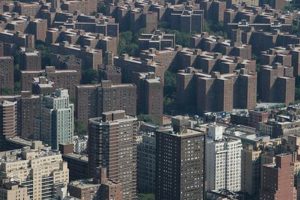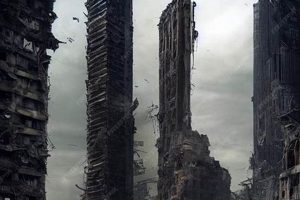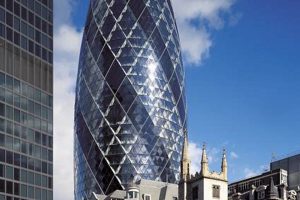Skyscrapers that soar high into the sky, reaching heights of over 300 meters (984 feet), are known as supertall skyscrapers. These architectural marvels are feats of engineering and design, pushing the boundaries of construction and offering breathtaking views from their lofty heights.
Supertall skyscrapers have become iconic landmarks in major cities around the world, attracting tourists and offering unique experiences. They provide valuable commercial and residential space, contributing to economic growth and urban development. Historically, the construction of supertall skyscrapers has been driven by technological advancements, architectural innovation, and a desire to create vertical cities that maximize space utilization.
In the following sections, we will delve deeper into the world of supertall skyscrapers, exploring their design, construction, and impact on urban landscapes. We will also examine some of the most notable supertall skyscrapers around the globe, showcasing their architectural brilliance and engineering prowess.
1. Height
Height is a defining characteristic of supertall skyscrapers, setting them apart from other buildings and contributing to their iconic status. These architectural giants reach extraordinary heights, typically exceeding 300 meters (984 feet). The pursuit of height in supertall skyscrapers is driven by several factors:
- Land scarcity: In densely populated urban areas, building upwards allows for maximum space utilization, providing more floor area for residential, commercial, and other uses.
- Urban planning: Supertall skyscrapers can serve as landmarks and focal points within a city, creating a distinct and recognizable skyline. They can also contribute to urban planning goals, such as concentrating development in specific areas and promoting vertical growth.
- Economic factors: Supertall skyscrapers offer premium office space with panoramic views, commanding higher rental rates and attracting prestigious tenants. They can also stimulate economic growth by driving tourism and creating job opportunities in construction, maintenance, and related industries.
- Architectural innovation: The design and construction of supertall skyscrapers push the boundaries of engineering and architectural innovation. They require advanced materials, innovative structural systems, and specialized construction techniques to ensure stability and safety at extreme heights.
The height of supertall skyscrapers presents both opportunities and challenges. While they offer stunning views, energy efficiency, and reduced land use, they also require careful consideration of factors such as wind resistance, seismic stability, and emergency evacuation plans. Overcoming these challenges has led to the development of innovative architectural and engineering solutions that have shaped the design of supertall skyscrapers worldwide.
In conclusion, height is a crucial aspect of supertall skyscrapers, influencing their design, construction, and impact on urban environments. The pursuit of height has driven architectural innovation and contributed to the creation of iconic landmarks that define skylines around the world.
2. Engineering
Engineering plays a vital role in the design and construction of supertall skyscrapers, as these architectural marvels push the boundaries of structural integrity and safety at extreme heights. To achieve these ambitious heights, engineers must overcome unique challenges and employ innovative solutions.
- Structural Systems: Supertall skyscrapers require robust structural systems to withstand gravity, wind, and seismic forces. Engineers utilize advanced materials such as high-strength concrete and steel, along with innovative structural designs like diagrid systems and outrigger frames, to ensure stability and prevent excessive sway.
- Wind Engineering: Wind poses a significant challenge for supertall skyscrapers due to their height and exposure to strong winds. Engineers conduct extensive wind tunnel testing and employ aerodynamic features, such as tuned mass dampers and wind baffles, to mitigate wind-induced vibrations and ensure occupant comfort.
- Seismic Engineering: In earthquake-prone regions, supertall skyscrapers must be designed to withstand seismic forces. Engineers incorporate base isolation systems, energy dissipation devices, and reinforced concrete cores to reduce seismic vulnerability and protect occupants during earthquakes.
- Fire Safety: Supertall skyscrapers present unique fire safety challenges due to their height and the large number of occupants. Engineers implement comprehensive fire safety measures, including fire-resistant materials, advanced sprinkler systems, and evacuation plans, to ensure the safety of occupants in the event of a fire.
Engineering innovation is at the forefront of supertall skyscraper design, as engineers continuously develop new and improved techniques to overcome the challenges of building at extreme heights. These engineering marvels not only redefine skylines but also contribute to our understanding of structural engineering and construction practices.
3. Design
Design is an integral aspect of supertall skyscrapers, shaping not only their aesthetic appearance but also their functionality, sustainability, and overall impact on the urban environment. The design of supertall skyscrapers involves a complex interplay of architectural vision, engineering constraints, and urban planning considerations.
- Form and Function: The design of supertall skyscrapers must carefully balance form and function. Architects and engineers work together to create structures that are both aesthetically pleasing and structurally sound. The shape and configuration of the building play a crucial role in optimizing wind resistance, maximizing natural light, and ensuring efficient use of space.
- Facade Engineering: The facade of a supertall skyscraper is not just an aesthetic element but also a critical component that contributes to the building’s overall performance. Architects and engineers design facades that incorporate energy-efficient glazing, shading systems, and other features to reduce energy consumption and enhance occupant comfort.
- Vertical Communities: Supertall skyscrapers are essentially vertical communities that house thousands of people. The design of these buildings must consider the needs of residents, workers, and visitors. This includes creating communal spaces, amenities, and transportation systems that foster a sense of community and wel
l-being. - Urban Context: The design of supertall skyscrapers must be sensitive to the surrounding urban context. Architects consider the scale, massing, and architectural style of neighboring buildings to ensure that the new skyscraper complements and enhances the existing cityscape.
In conclusion, the design of supertall skyscrapers is a multidisciplinary endeavor that requires collaboration between architects, engineers, and urban planners. By carefully considering form, function, facade engineering, vertical communities, and urban context, designers create supertall skyscrapers that are not only iconic landmarks but also sustainable, functional, and integrated into the fabric of the city.
4. Construction
Construction plays a pivotal role in bringing supertall skyscrapers from architectural concepts to physical realities. These extraordinary structures require innovative construction techniques and meticulous planning to overcome the challenges of extreme height and ensure safety, stability, and durability.
- Foundation and Substructure: The foundation of a supertall skyscraper must be exceptionally strong and deep to support the immense weight of the structure. Engineers often employ piled foundations, which involve driving steel or concrete piles deep into the ground to create a stable base.
- Structural Assembly: Supertall skyscrapers typically use steel or reinforced concrete as their primary structural materials. Steel beams and columns are assembled into a framework that provides the building’s skeletal support. Concrete is used to fill in the spaces between the beams and columns, creating a robust and fire-resistant structure.
- Vertical Transportation: Supertall skyscrapers require efficient and reliable vertical transportation systems to move people and goods throughout the building. High-speed elevators and sky lobbies are often used to facilitate quick and convenient movement.
- Safety and Fire Protection: Construction of supertall skyscrapers incorporates comprehensive safety and fire protection measures. Fire-resistant materials, sprinkler systems, and advanced evacuation plans are implemented to ensure the safety of occupants in the event of an emergency.
The construction of supertall skyscrapers is a remarkable feat of engineering and collaboration, requiring expertise in various disciplines, including structural engineering, construction management, and safety protocols. These construction techniques and strategies enable the creation of these architectural marvels that redefine skylines and push the boundaries of human ingenuity.
5. Sustainability
In the realm of supertall skyscrapers, sustainability has emerged as a critical consideration, shaping design, construction, and operation practices to minimize environmental impact and promote responsible resource utilization.
- Energy Efficiency: Supertall skyscrapers are inherently energy-intensive structures. Architects and engineers employ various strategies to enhance energy efficiency, including high-performance building envelopes, energy-efficient lighting systems, and renewable energy sources such as solar panels and wind turbines.
- Water Conservation: Water conservation is essential in supertall skyscrapers, given their large populations and water consumption. Low-flow fixtures, rainwater harvesting systems, and efficient irrigation techniques are implemented to reduce water usage and conserve this precious resource.
- Material Selection: Sustainable material selection plays a vital role in reducing the environmental footprint of supertall skyscrapers. Architects and engineers opt for eco-friendly materials, such as recycled steel, low-VOC paints, and sustainable wood, to minimize the building’s embodied carbon and promote responsible sourcing.
- Waste Management: Waste management is a significant challenge in supertall skyscrapers due to the large volume of waste generated during construction and operation. Comprehensive waste management plans, including recycling, composting, and waste reduction initiatives, are implemented to divert waste from landfills and promote circularity.
By embracing sustainability, supertall skyscrapers can mitigate their environmental impact, contribute to the well-being of occupants and the surrounding community, and set a positive example for responsible urban development. These sustainable practices not only reduce operating costs but also enhance the long-term value and legacy of these architectural marvels.
6. Urban impact
Supertall skyscrapers, with their towering heights and iconic presence, have a profound impact on the urban environment. Their construction and presence reshape skylines, influence urban planning, and affect the social and economic dynamics of cities.
- Transformation of Skylines: Supertall skyscrapers redefine city skylines, becoming landmarks that symbolize progress, innovation, and economic vitality. Their unique designs and heights create distinctive visual identities for cities, attracting tourism and investment.
- Urban Planning and Density: Supertall skyscrapers allow for concentrated development, accommodating large populations within a smaller footprint. This can help reduce urban sprawl, conserve land, and promote efficient use of infrastructure. However, it also requires careful planning to ensure adequate public spaces, transportation, and supporting infrastructure.
- Economic Development and Job Creation: The construction and operation of supertall skyscrapers generate significant economic activity, creating jobs in architecture, engineering, construction, and related industries. They can also attract businesses and investment, contributing to the overall economic growth of the city.
- Social and Cultural Impact: Supertall skyscrapers can become iconic symbols of civic pride and cultural identity. They can also create new social spaces and gathering points, such as observation decks, restaurants, and public plazas, fostering a sense of community and urban vibrancy.
In conclusion, the urban impact of supertall skyscrapers is multifaceted, affecting skylines, urban planning, economic development, and social dynamics. Careful planning and design are essential to maximize the benefits and mitigate potential challenges, ensuring that these architectural wonders contribute positively to the overall fabric and vitality of cities.
7. Economic impact
Supertall skyscrapers have a significant economic impact on cities. Their construction and operation generate thousands of jobs in architecture, engineering, construction, and related industries. The presence of supertall skyscrapers can also attract businesses and investment, contributing to the overall economic growth of the city. For
example, the construction of the Burj Khalifa in Dubai created over 12,000 jobs and is estimated to have contributed over $2 billion to the local economy. Similarly, the One World Trade Center in New York City is estimated to have generated over $10 billion in economic activity during its construction.
In addition to job creation and investment, supertall skyscrapers can also boost tourism. Visitors from around the world are drawn to these iconic structures, which offer breathtaking views and unique experiences. For example, the observation deck of the Burj Khalifa is one of the most popular tourist attractions in Dubai, attracting over 2 million visitors per year. The economic impact of tourism can extend beyond the direct revenue generated by ticket sales, as visitors often spend money on other activities such as dining, shopping, and transportation.
However, it is important to note that the economic impact of supertall skyscrapers is not always positive. The construction and operation of these buildings can be very expensive, and there is a risk that they will not be able to generate enough revenue to cover their costs. In some cases, supertall skyscrapers can also lead to gentrification and displacement of low-income residents. Therefore, it is important to carefully consider the potential economic and social impacts of supertall skyscrapers before approving their construction.
8. Cultural significance
Supertall skyscrapers are not just architectural marvels; they also hold cultural significance and have become symbols of national pride, economic power, and technological advancement. These iconic structures often embody the aspirations and values of the cities and countries they reside in.
One of the most striking examples of the cultural significance of supertall skyscrapers is the Burj Khalifa in Dubai. Standing at over 828 meters tall, the Burj Khalifa is not only the tallest building in the world but also a symbol of Dubai’s rapid economic growth and its ambition to become a global hub for business and tourism. The building’s unique design, inspired by the region’s Islamic architecture, has made it an instantly recognizable landmark and a source of national pride for the United Arab Emirates.
Another example is the Shanghai Tower in China. At 632 meters tall, the Shanghai Tower is the tallest building in China and the second tallest in the world. The building’s design is inspired by traditional Chinese architecture and incorporates elements such as the pagoda and the ruyi scepter. The Shanghai Tower has become a symbol of China’s growing economic and technological prowess and a source of national pride for the Chinese people.
Supertall skyscrapers can also have a positive impact on the cultural life of a city. For example, the One World Trade Center in New York City has become a symbol of resilience and renewal after the 9/11 attacks. The building’s observation deck, which offers panoramic views of the city, has become a popular tourist attraction and a place for New Yorkers to gather and celebrate their city.
However, supertall skyscrapers can also be controversial. Some critics argue that these buildings are too expensive, too energy-intensive, and too disruptive to the surrounding environment. Others argue that supertall skyscrapers are simply a symbol of inequality and excess. Despite these criticisms, supertall skyscrapers continue to be built around the world, as they represent the ambition, innovation, and cultural aspirations of the cities they reside in.
Frequently Asked Questions about Supertall Skyscrapers
Supertall skyscrapers, architectural marvels reaching extraordinary heights, often spark questions and curiosity. This section addresses some frequently asked questions about these iconic structures, providing concise and informative answers.
Question 1: What defines a supertall skyscraper?
Supertall skyscrapers are defined as buildings that rise over 300 meters (984 feet) in height, making them exceptionally tall structures that reshape skylines and urban landscapes.
Question 2: What are the key considerations in designing supertall skyscrapers?
Designing supertall skyscrapers involves a complex interplay of architectural vision, engineering constraints, and urban planning factors. Architects and engineers must carefully balance form and function, ensuring structural integrity, energy efficiency, and integration with the surrounding environment.
Question 3: How do supertall skyscrapers withstand extreme heights and wind forces?
Supertall skyscrapers employ advanced engineering techniques to resist extreme heights and wind forces. These techniques include robust structural systems, wind-resistant designs, and innovative materials that enhance stability and minimize sway.
Question 4: Are supertall skyscrapers sustainable?
Sustainability is a growing concern in supertall skyscraper design. Architects and engineers are incorporating energy-efficient systems, water conservation measures, sustainable material selection, and waste management strategies to reduce environmental impact and promote responsible resource utilization.
Question 5: How do supertall skyscrapers impact urban environments?
Supertall skyscrapers have a significant impact on urban environments. They transform skylines, influence urban planning, and contribute to economic development. However, careful planning and design are crucial to mitigate potential challenges and ensure these structures positively contribute to the overall fabric and vitality of cities.
Question 6: What are some notable examples of supertall skyscrapers around the world?
Iconic supertall skyscrapers include the Burj Khalifa in Dubai, the Shanghai Tower in China, and the One World Trade Center in New York City. These structures represent architectural innovation, engineering prowess, and the ambition of cities to create vertical landmarks that redefine skylines and symbolize progress.
In summary, supertall skyscrapers are architectural wonders that push the boundaries of design and engineering. By addressing common questions and concerns, this FAQ section provides a deeper understanding of these iconic structures and their impact on urban environments.
Continue reading to explore specific case studies and delve into the architectural details, engineering challenges, and sustainability initiatives of notable supertall skyscrapers worldwide.
Tips for Designing Supertall Skyscrapers
The design and construction of supertall skyscrapers present unique challenges and require careful consideration of various factors. Here are some tips for architects and engineers to approach the design of these architectural marvels:
Tip 1: Prioritize Structural Integrity
Supertall skyscrapers must withstand extreme heights and wind forces. Employ robust structural systems, such as diagrid frameworks and outrigger columns, to ensure stability and minimize sway.
Tip 2: Embrace Sustainable Design
Incorporate energy-efficient systems, water conservation measures, sustainable material selection, and waste management strategies to reduce environmental impact and promote responsible resource utilization.
Tip 3: Optimize Form and Function
Carefully balance the aesthetic and functional aspects of the design. Consider factors such as wind resistance, natural light optimization, and efficient use of space.
Tip 4: Enhance Vertical Transportation
Design efficient vertical transportation systems, including high-speed elevators and sky lobbies, to facilitate quick and convenient movement throughout the building.
Tip 5: Integrate with the Urban Context
Consider the scale, massing, and architectural style of neighboring buildings to ensure that the supertall skyscraper complements and enhances the existing cityscape.
Tip 6: Focus on Safety and Fire Protection
Implement comprehensive safety and fire protection measures, such as fire-resistant materials, advanced sprinkler systems, and robust evacuation plans, to ensure occupant safety in the event of an emergency.
Tip 7: Leverage Advanced Technologies
Utilize innovative technologies, such as wind tunnels and building information modeling (BIM), to optimize design, predict performance, and enhance construction efficiency.
Tip 8: Collaborate with Experts
Foster collaboration between architects, engineers, urban planners, and other stakeholders to ensure a comprehensive and successful design process for the supertall skyscraper.
By following these tips, architects and engineers can create supertall skyscrapers that are not only iconic landmarks but also sustainable, functional, and integrated into the fabric of the city.
Continue reading to explore specific case studies and delve into the architectural details, engineering challenges, and sustainability initiatives of notable supertall skyscrapers worldwide.
Conclusion
Supertall skyscrapers, architectural marvels that soar towards the heavens, have reshaped skylines and transformed urban landscapes around the world. Their design and construction push the boundaries of engineering and architectural innovation, offering unique perspectives and experiences.
As we look towards the future of supertall skyscrapers, sustainability and resilience will play an increasingly critical role. Architects and engineers must continue to innovate and develop sustainable design strategies that minimize environmental impact and enhance occupant well-being. Furthermore, the integration of advanced technologies, such as AI and IoT, holds immense potential for optimizing building performance, reducing energy consumption, and creating smarter, more responsive supertall skyscrapers.
The pursuit of supertall skyscrapers will undoubtedly continue, driven by a desire for architectural excellence, economic growth, and urban transformation. By embracing sustainability, leveraging innovation, and fostering collaboration, we can create supertall skyscrapers that are not only iconic landmarks but also responsible and sustainable additions to our cities.







